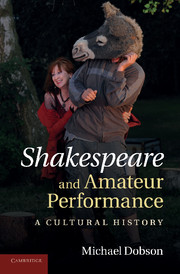Book contents
- Frontmatter
- Contents
- List of illustrations
- Acknowledgements
- Introduction: Shakespeare in culture
- 1 Shakespeare in private: domestic performance
- 2 Shakespeare in public: the resisted rise of the amateur dramatic society
- 3 Shakespeare in exile: expatriate performance
- 4 Shakespeare in the open: outdoor performance
- Conclusion
- Notes
- Index
4 - Shakespeare in the open: outdoor performance
Published online by Cambridge University Press: 05 December 2011
- Frontmatter
- Contents
- List of illustrations
- Acknowledgements
- Introduction: Shakespeare in culture
- 1 Shakespeare in private: domestic performance
- 2 Shakespeare in public: the resisted rise of the amateur dramatic society
- 3 Shakespeare in exile: expatriate performance
- 4 Shakespeare in the open: outdoor performance
- Conclusion
- Notes
- Index
Summary
quince Pat, pat; and here's a marvellous convenient place for our rehearsal. This green plot shall be our stage, this hawthorn brake our tiring-house …
(A Midsummer Night's Dream, 3.1.2–4)It would not be fair to say that the collective idealism which filled Britain with amateur dramatic societies in the 1920s and 1930s and sustained such enterprises as the National Theatre of Hohenfels in the early 1940s has completely dissipated since the end of the Second World War. It might be accurate, however, to suggest that it has found different channels of expression, and that these have often by-passed the non-professional stage. Since the passage of the National Theatre Act in 1949, the establishment of the Royal Shakespeare Company in 1960 and the belated inauguration of the National Theatre Company at the Old Vic in 1963, amateur societies and specialist clubs have no longer had a near-monopoly on the performance of plays which could not be guaranteed a commercially viable run in the West End, especially those of Shakespeare. The post-war expansion of universities (some with new-fangled drama departments, such as the country's first, at Bristol, founded in 1946) provided an outlet for much young talent which might otherwise have gone into local amateur groups, while the establishment of the Fringe alongside the first Edinburgh Festival in 1947 offered a new forum for avant-garde theatre on the borderline between student drama and the profession.
- Type
- Chapter
- Information
- Shakespeare and Amateur PerformanceA Cultural History, pp. 152 - 196Publisher: Cambridge University PressPrint publication year: 2011



